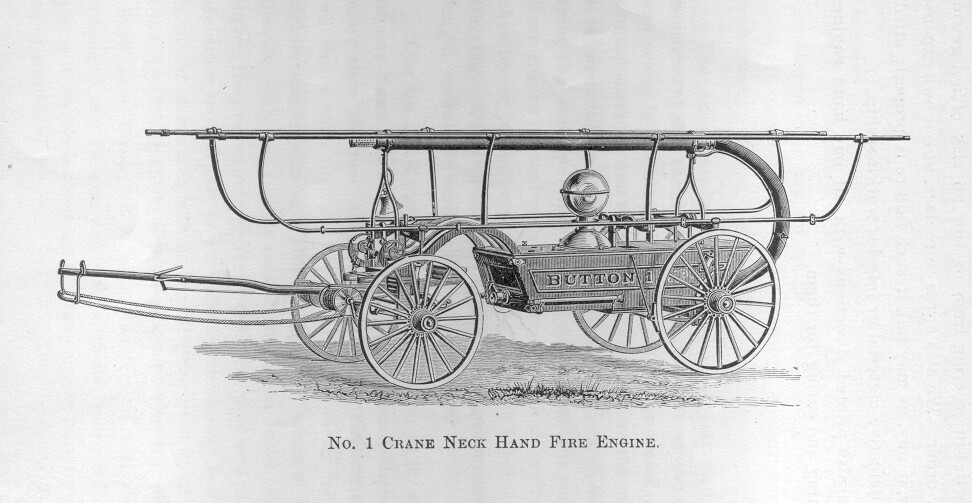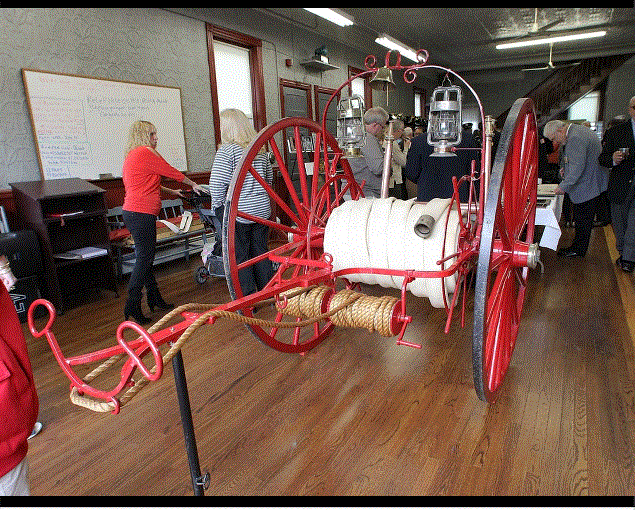On Sunday evening, January 22, 1854, Rev Dr. Freeman of the Presbyterian Church on Clinton Street was delivering an address from the pulpit when someone in the audience, after hearing an alarm, went outside to investigate, only to come back shouting “We’re all on fire”. As the doctor described it, ‘there were coattails flying, and a retreat of men, women, and children, leaving me to suspend services without the Benediction’.
The cause of the alarm was the burning of a barn, and the loss was estimated at $2500.00 and as a direct result, the Citizens of Warren organized a subscription to privately raise funds to purchase both a Hook and Ladder and Hand Engine to be manned by Volunteers.
On January 28, just six days later, a meeting was held at the Ballroom of the American Hotel and the meeting was a success. While sufficient funds had been available to purchase a Hook and Ladder, the Hand Engine subscription failed. Rescue Hook and Ladder was formed that night.
On April 24th, 1854, the newly formed Village of Warren had appropriated $1200.00 for a fire engine and hose carriage and 400 feet of hose, and on May 15th, the Warren Engine Company came into being.
In early September the Rockland County Messenger published the following announcement: “Just as we go to press, this splendid machine, with hose carriage attached, is passing our office. The Machine, and the newly uniformed company belonging to it, rather eclipsed the glory of the old ‘Rescue’”.
The formation of a Fire Department was one of the controlling reasons for the Incorporation of a portion of the Township of Haverstraw into the Village of Warren. Several disastrous fires had visited the community and while a Hook and Ladder company had been formed by popular subscription its equipment only permitted it to act as a bucket brigade to extinguish fire. Prior to the incorporation of the village considerable agitation was afoot in the community to purchase a fire engine but efforts to do so by subscription failed. The only solution was Incorporation where this problem and others including water supplies could be solved by taxation.
Warren Engine Company No.1
On May 15th, 1854 the Warren Engine Company No.1 was organized and the following officers and members are charter members
G. Meyers, Foreman; H. VerValen, E.M. Farrington, W.W. Oldfield, D. DeNoyelles, S. Requa, G.B. Bullis, J. Miller, W. Seasby, G. Snedeker, G. Anderson, H. Stagg, W. Schank, S. Newman, S. Fowler, G. Ward, P. Schoonmaker, N. DeGroat, H. Jones, F. Glassing, T. Brennan, T. Murphy, R. Mackey, W. Ferdon, J. Phillips, J. Serat, M. Flynn and L. Whittaker.
This company was accepted by the Board of Trustees and became the first company in the Warren Fire Department. However, they were a company without a truck, hose, or home and it was several months before they received their machine and moved into their firehouse.
Middle Street
On September 1st, 1854, the Village of Warren purchased from Mr. Isaiah Millburn a building at what is now 36 Middle Street. As you can see from this picture, the bay door has been bricked over, but is quite visible. The flagstaff also still remained. This picture is from the mid 1950′s.
First Alarm
The first fire attended by the company was mutual aid, and was to Garnerville N.Y. on September 7th, 1854. It involved a barn a little west of the Garner home, what is now 18 Railroad Avenue. Rescue Hook and Ladder was called to this fire, and the Rockland County Messenger commented “We saw a number of Warren Engine Company members assisting their brothers of Rescue Hook and Ladder at this destructive occurrence. This is as it should be. They expect their machine every day on the Steamer from New York”.
Button Pumper
On September 21st, 1854 the machine did arrive on the river steamer Armenia from New York City for there was no train service into the village in those days. It was manufactured by L. Button & Company of Waterford, NY and was known as a Piano or Piano Box, so called because it was thought that its box-like body resembled a piano. The village records show that the bill for the fire engine, hose and hose carriage was audited and approved at $1089.00.
General Warren Engine Company No. 1
According to the Village Minutes a petition was presented to them on March 31st, 1870 “praying the Board to Change the name of Warren Fire Engine Company No. 1 to General Warren Engine Company No. 1, which was, on motion, granted. Thus the metamorphosis of the company name. Under an Act of the Legislature passed April 14, 1874 the Corporate name of the Village was changed from Warren to Haverstraw and the Fire Department was changed accordingly.
By 1885, it was recommended to the Board of Engineers that fire hydrants be placed throughout the Village to improve fire protection. This work was to commence the next spring, and by July 6th, 1886 it was reported that 13 hydrants were in service. By October 5th, 1886 it was reported that 37 hydrants were in service and this set the stage for the hose carts.
At this time General Warren, Union, and Triumph responded with handtubs and hose reels while Lady Warren had a steamer. They drafted water from cisterns and other sources throughout the Village. With the advent of the pressurized water system, pumps were no longer needed to draw water from the village cisterns, and as a result, the village sold the Lady Warren Steamer, and put all of the hand engines in storage.
General Warren Hose Company #2
Four wheeled Hose Carriages were purchased by the Village and distributed to the companies. In a later development, two wheeled hose carts were purchased to replace the bigger and heavier 4 wheeled variety, and the 4 wheeled versions were kept by the companies and used as Parade Carriages.
In 1887 the company name was again changed to General Warren Hose Company #2. Our old engine was last seen on public display at a parade in the Village on June 17th, 1903. Interestingly, the old Engine, which was purchased in 1857 for Union was stored in a barn behind the Corporation Rooms on Fourth Street until 1930, when it was accidentally destroyed.






